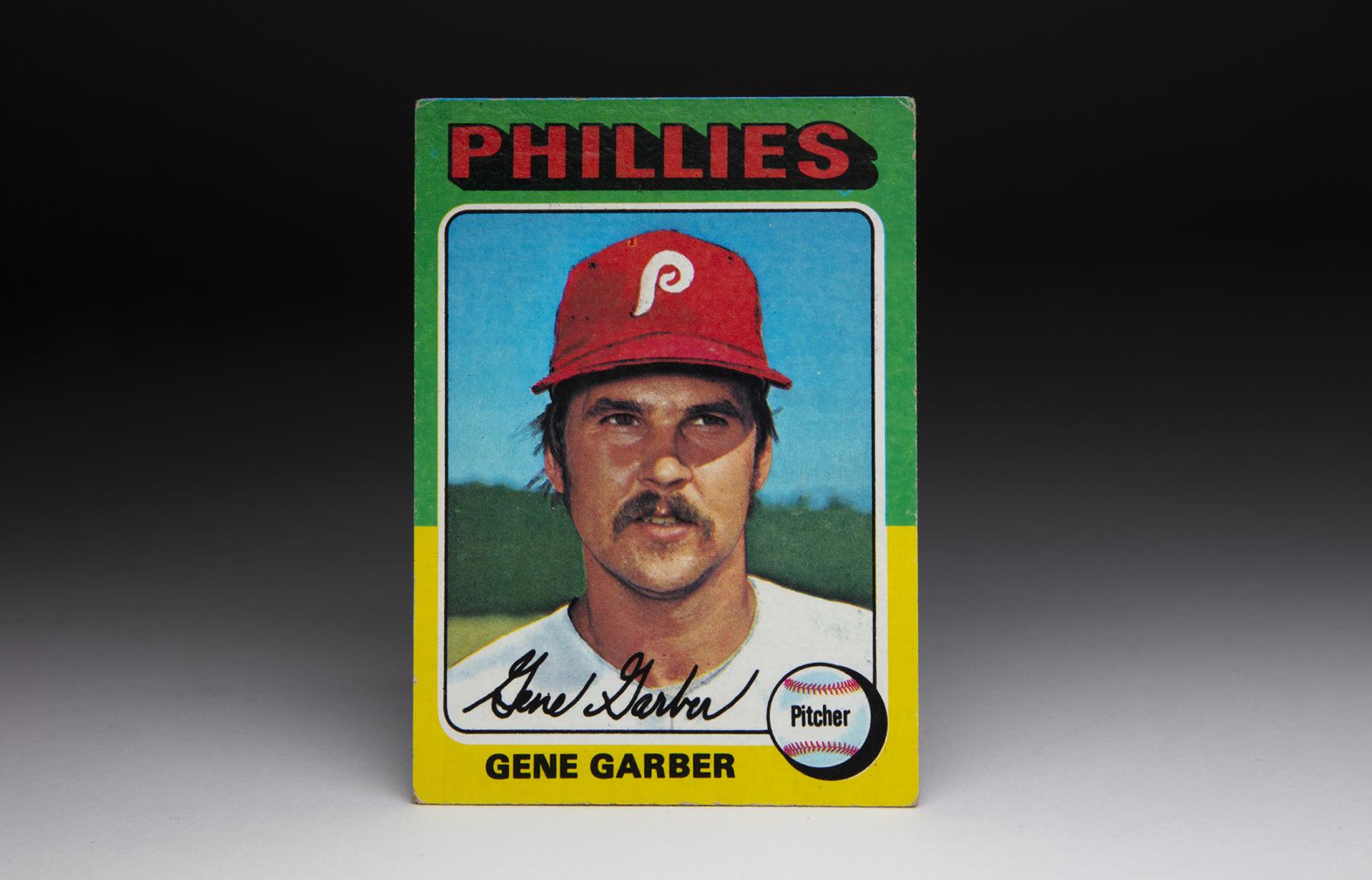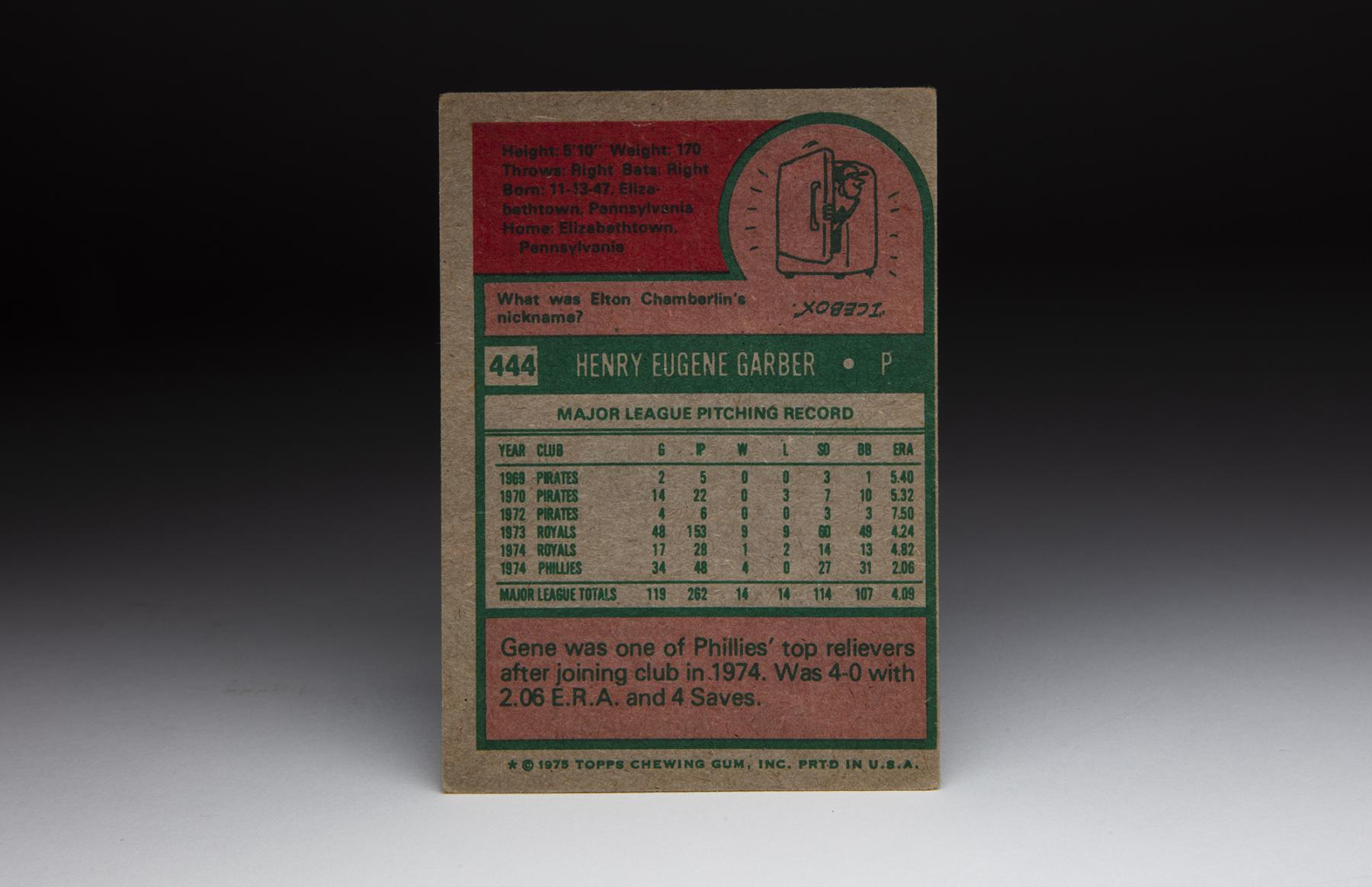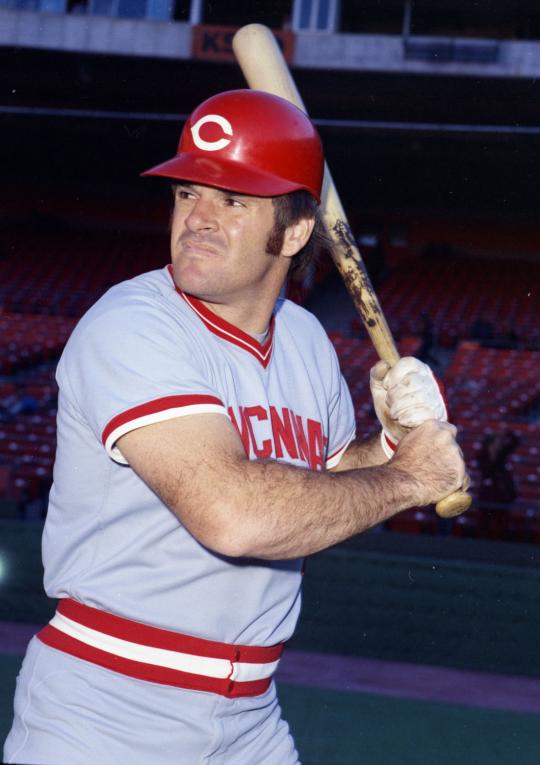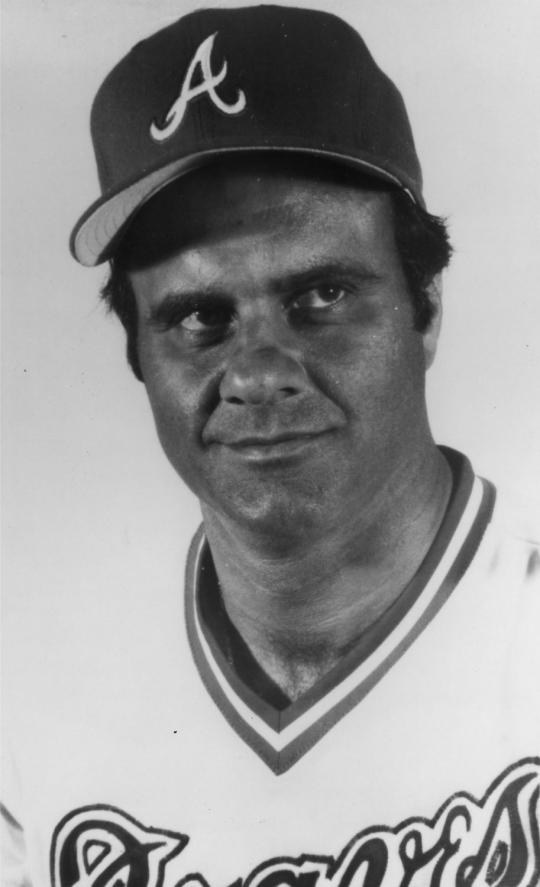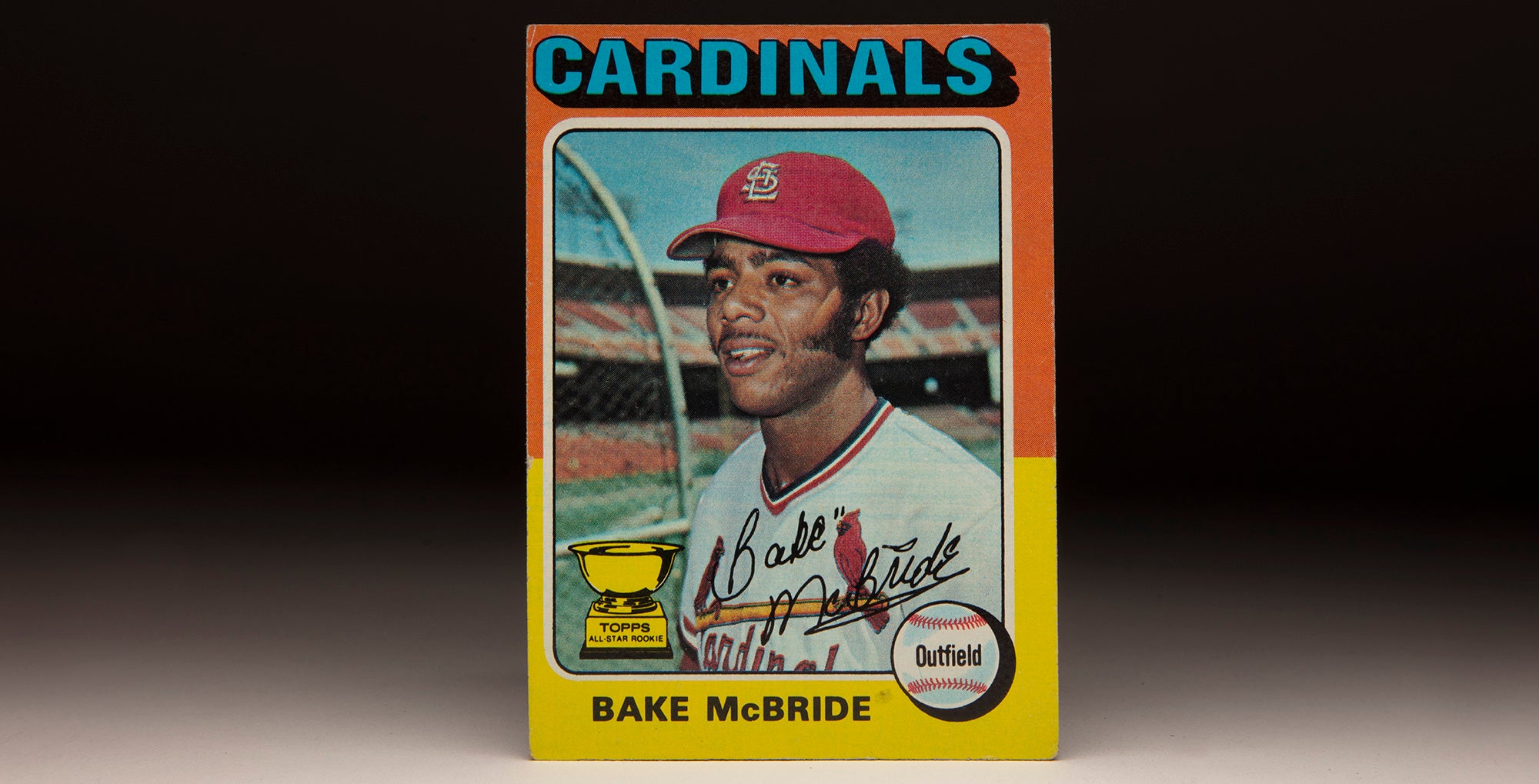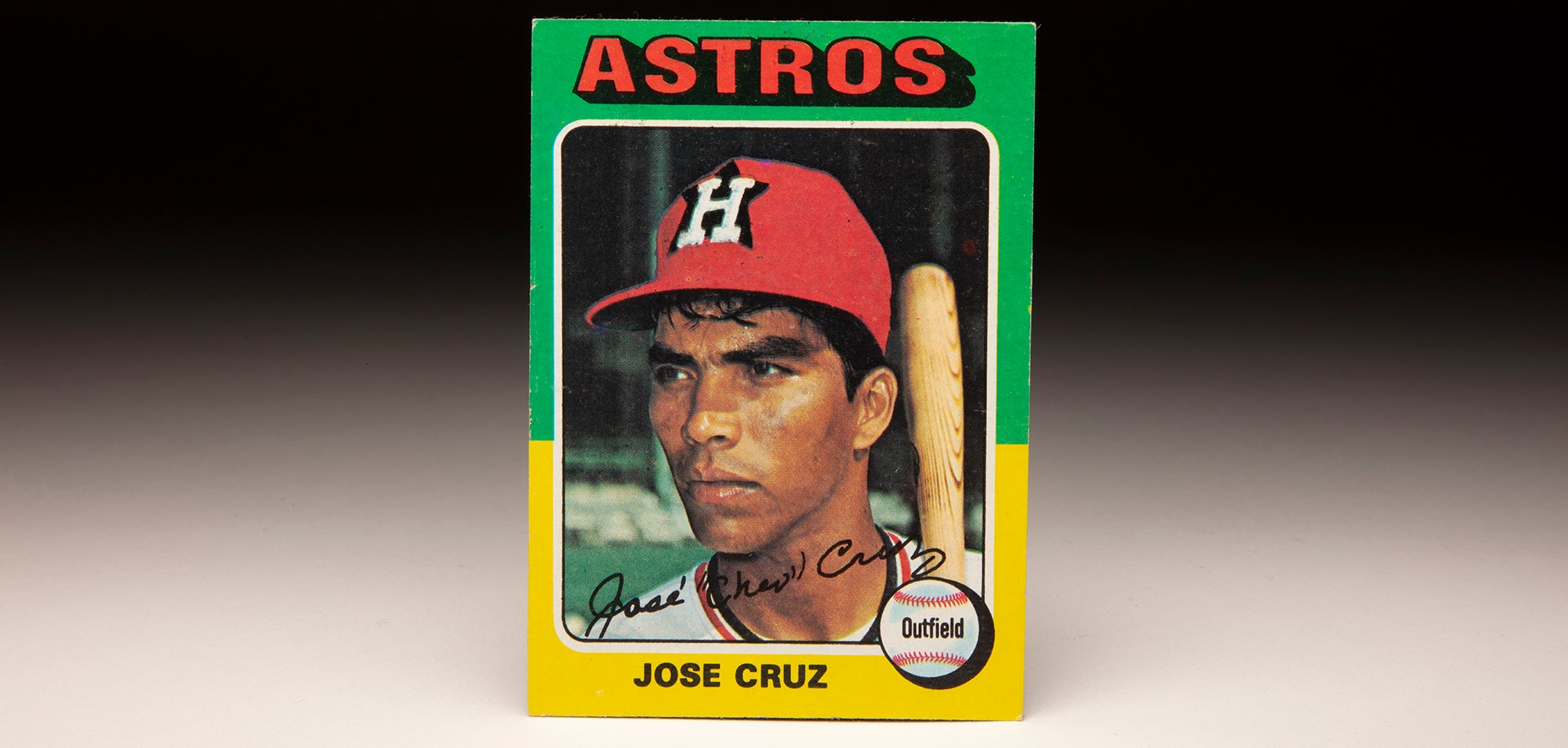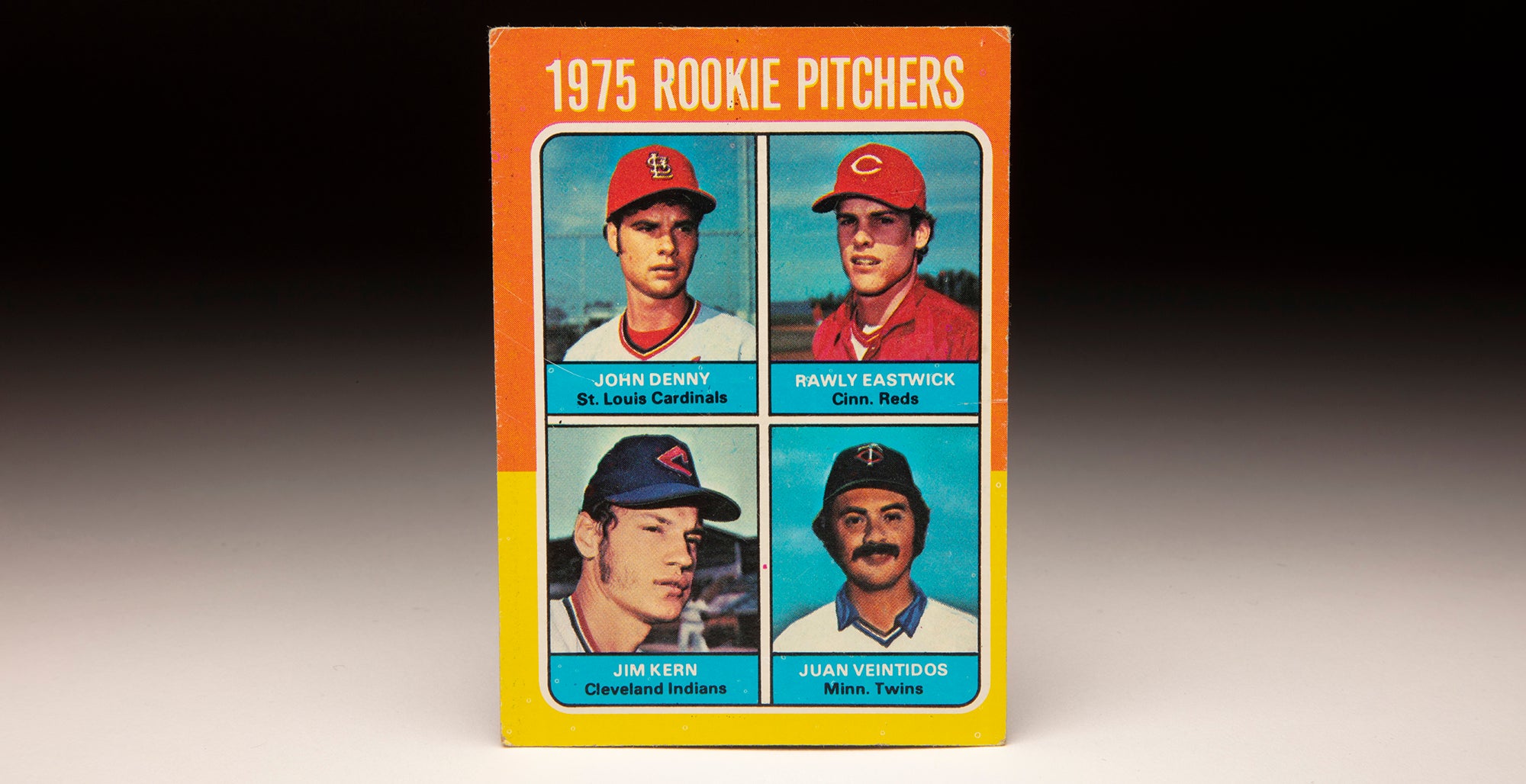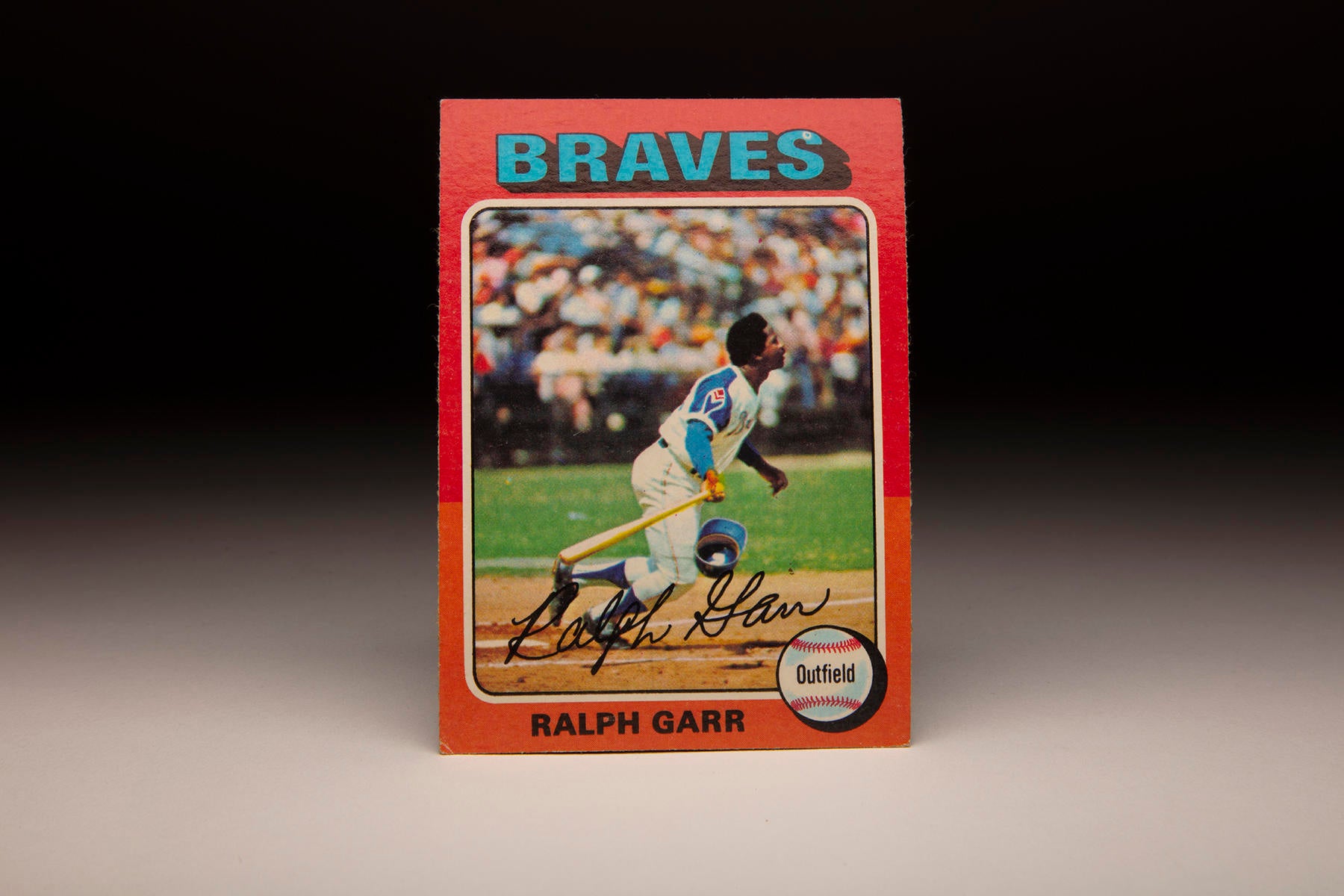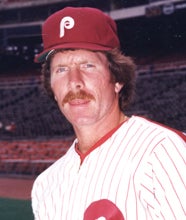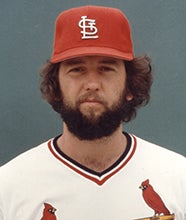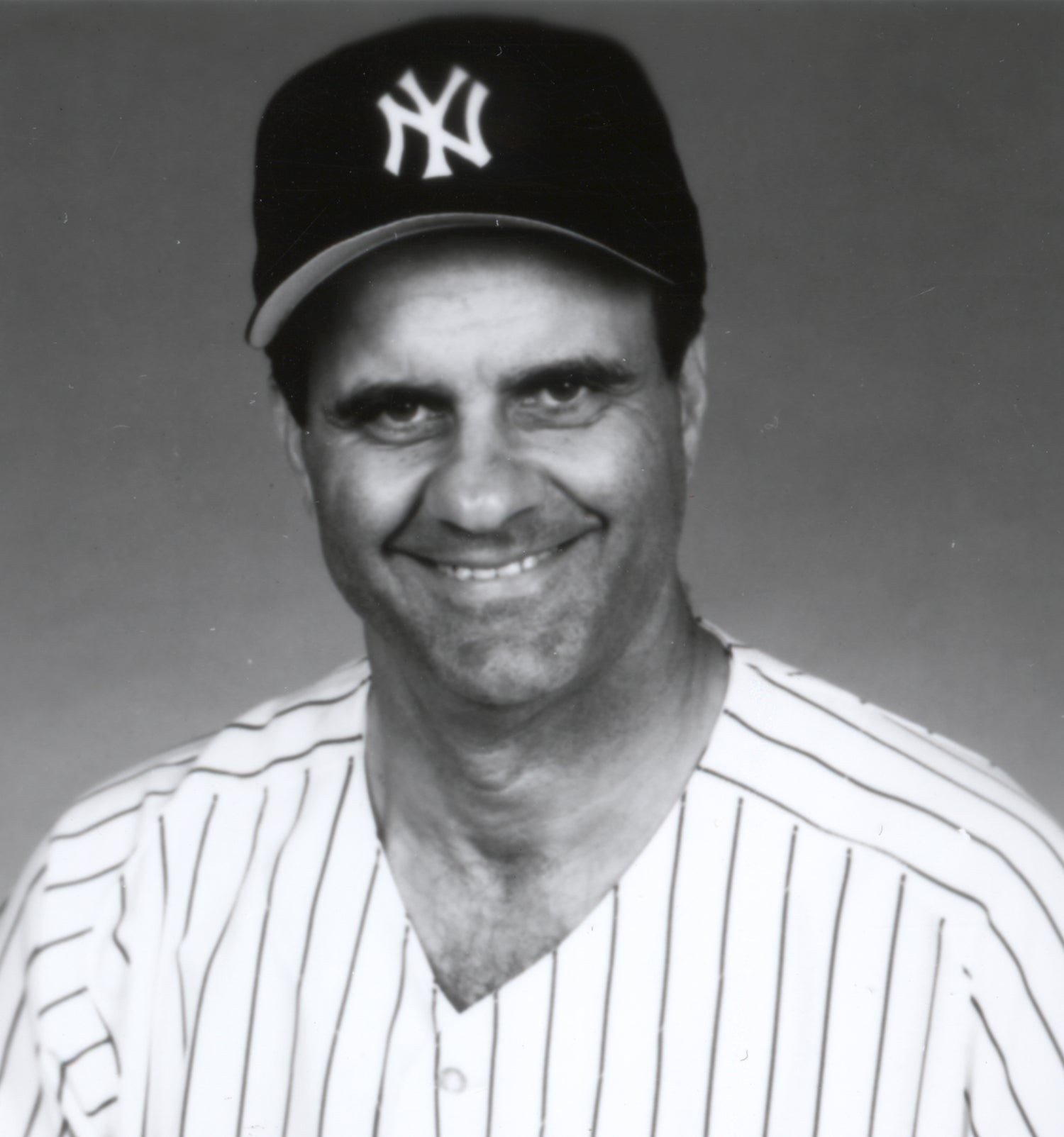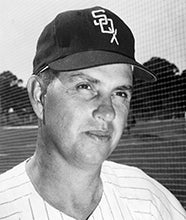- Home
- Our Stories
- #CardCorner: 1975 Topps Gene Garber
#CardCorner: 1975 Topps Gene Garber
On Aug. 1, 1978, Gene Garber was at the center of the baseball world – thanks to the 44-game hitting streak by the Reds’ Pete Rose.
And when Garber struck out Rose to end the Braves’ 16-4 win – and snap Rose’s hitting streak – the sidewinding right-hander leapt off the mound in front of 31,159 fans at Atlanta-Fulton County Stadium and thrust both hands in the air.
For the ultra-competitive Garber, snuffing out Rose’s streak was a chance to show a national audience that he was one of the best relievers of his era.
Henry Eugene Garber was born Nov. 13, 1947, in Lancaster, Pa. Raised on a dairy farm in nearby Elizabethtown, Garber played varsity baseball for four seasons in high school and spent two years on the varsity basketball team. During his senior season at Elizabethtown High School, Garber pitched five one-hitters while going 5-1 in seven games, striking out 113 batters in 52 innings. In a nine inning scoreless tie against rival Donegal High School, Garber fanned 27.
Following his high school graduation, Garber was selected in the 20th round of the inaugural MLB Draft by the Pittsburgh Pirates. He spent most of the 1965 season with Class A Batavia of the New York-Penn League, were he was 4-3 with a 3.50 ERA. He then returned home and enrolled at Elizabethtown College.
Hall of Fame Membership
There is no simpler, and more essential, way to demonstrate your support than to sign on as a Museum Member.
Be A Part of Something Greater
There are a few ways our supporters stay involved, from membership and mission support to golf and donor experiences. The greatest moments in baseball history can’t be preserved without your help. Join us today.
“When I left for my first professional team, I was 17 and had never been away from home before,” Garber told the Elizabethtown Chronicle. “In high school, I was always the big star. And then in that first week (in the minors) all the glory of baseball was lost when I looked over to the locker next to mine and saw it was empty. I knew then it’s either perform or you’re gone.”
For the next few seasons, Garber balanced his studies – he would eventually earn a degree in political science – with his pitching. He went 4-4 with a 4.60 ERA at Class A Raleigh of the Carolina League in 1966, then returned to Raleigh in 1967 – where he went 8-6 with a 1.89 ERA in 138 innings.
Still a starting pitcher at this point, Garber was promoted to Double-A York of the Eastern League in 1968. Pitching a short 25 miles from his home, Garber went 7-2 with a 1.60 ERA in 16 starts before earning a promotion to Triple-A Columbus in July.
At the end of his career, Gene Garber ranked seventh all-time with 218 saves and sixth all-time with 931 games pitched – but he always seemed to have to go the extra mile to prove he belonged in the big leagues. (Topps baseball card photographed by Milo Stewart Jr./National Baseball Hall of Fame and Museum)
“We thought he had pitched extremely well (at York), and Columbus needed some help in the pitching department,” Pirates farm director Harding Peterson told the Lancaster New Era. “His attitude toward the game is outstanding. You have to work hard and have some physical ability to go along with it, which he does.”
Upon his promotion to Triple-A, the Pirates converted Garber – who was already using a sidearm delivery that produced an effective sinker – to a relief pitcher. Garber was against the move at first, but he thrived in the role, going 5-1 with a 2.44 ERA in 23 appearances. The Pirates brought Garber to the majors in September following the end of the minor league season, but he did not appear in a game.
Garber returned to Double-A York to start the 1969 season so he could complete his degree at Elizabethtown College. Following graduation, Garber was brought to Pittsburgh to replace Bob Moose, who was doing a two-week tour of duty with the United States Marine Corps.
“He’s gotten a lot stronger since last year,” York manager Joe Morgan, who would go on to manage the Boston Red Sox from 1988-91, told the Intelligencer Journal of Lancaster, Pa. “Up until this year, he needed regular rest. Now he can pitch four or five times a week and stay tough.”
Garber made his big league debut on June 17 with 4.1 innings in a start against the Cubs. He recorded two outs in a relief appearance three days later before being sent back to Columbus, where he was 7-6 with a 3.07 ERA mainly as a starter for the remainder of the season.
Garber impressed the Pirates in Spring Training of 1970 and made the Opening Day roster. But after a bumpy first two months that left him with an 0-3 record and 5.24 ERA, Garber was sent back to Columbus, where he was 5-2 with a 4.74 ERA as both a reliever and a starter.
Following the season, the Pirates outrighted him to Columbus – and the franchise moved to Charleston, W.Va. for the 1971 campaign. Garber, however, refused to give up on his big league dream – even pitching winter ball in the Caribbean for several years to hone his control.
Spending all the 1971 season with Charleston – save for a few weeks of duty in the Pennsylvania National Guard – Garber went 14-6 with a 4.18 ERA in 24 starts. He returned to Charleston in 1972, and this time went 14-3 with a 2.26 ERA to earn the International League’s Pitcher of the Year Award.
Garber also earned a mid-season call-up to the Pirates, where he allowed five earned runs in 6.1 innings before being returned to the minors.
But on Oct. 25, 1972, Garber finally got the break he needed. That day, the Pirates sent him to the Royals in exchange for another struggling pitcher: Jim Rooker. The deal would profit both sides, though Garber’s best seasons came after his stint in Kansas City.
“When I got traded, I felt like a guy on death row who just got paroled,” Garber told the Elizabethtown Chronicle. “It was just like a whole new life opening up for me. The Pirates had lost confidence in me. I had lost confidence in them.”
Firmly entrenched on the Royals roster from the start of the season, Garber earned his first big league win in his first appearance with Kansas City, pitching 5.2 innings of two-run relief in a 9-6 win over Texas on April 11. He finished the season with a 9-9 record and a 4.24 ERA over 48 appearances, working 152.2 innings and earning 11 saves to go along with four complete games in eight starts.
But in 1974, Garber was sporting a 1-2 record with a 4.82 ERA in 17 games when the Royals sent him to Triple-A Omaha. Frustrated, Garber asked the Royals if he could explore a deal with other franchises. On July 12 – before Garber appeared in a game for Omaha – the Phillies purchased Garber’s contract and sent him Triple-A Toledo, where he went 2-1 with an 0.41 ERA in three starts.
He soon was summoned to Philadelphia, where Garber went 4-0 with a 2.06 ERA in 34 relief appearances in the second half of the 1974 season.
“I feel I was as good a pitcher in 1970 as I am now,” Garber told the Elizabethtown Chronicle in Spring Training of 1975. “But instead of six years in the big leagues I got two.”
Garber and newly acquired Tug McGraw were the stalwarts of a revamped Philadelphia bullpen that in 1975 helped the Phillies to a mark of 86-76 – the team’s first winning season in eight years. Garber was 10-12 with 14 saves – equaling McGraw’s total – in a National League-best 71 appearances.
Now at 28 years of age entering the 1976 season, Garber was ready to take his place as one of the game’s most dependable relief pitchers.
Garber, however, was anything but content. During the Spring Training lockout in 1976 while the new collective bargaining agreement was being negotiated, Garber’s name was splashed across papers around the country in an Associated Press story that detailed his paying his own living expenses while working out at the Phillies’ complex in Clearwater, Fla.
“Maybe it’s mental or something,” Garber said, “but I’m working as hard or harder than I would during regular Spring Training.”
That work paid off as Garber went 9-3 with a 2.82 ERA and 11 saves in 59 games as the Phillies won the NL East title. Philadelphia was swept by the Reds in the NLCS – with Garber taking the loss in Game 3 – but the future was bright for both the pitcher and the franchise.
Garber was even better in 1977, going 8-6 with 19 saves and a 2.35 ERA in 64 games. The Phillies repeated as division champions and faced the Dodgers in the NLCS.
In Game 1, Garber entered the contest in the seventh inning in relief of Steve Carlton, stopping a Los Angeles rally with a strikeout of Dusty Baker to keep the game tied at 5. After Garber pitched a scoreless eighth inning, the Phillies scored twice in the top of the ninth. Tug McGraw retired the side in order to end the game and give Garber the victory.
But the Dodgers won Game 2 to even the best-of-5 series. And in Game 3, Garber entered in the seventh inning with the score tied at 3. He retired the Dodgers in order in the seventh and eighth, and the Phillies scored two in the bottom of the eighth, leaving them three outs away from a 2-games-to-1 series lead.
Garber, however, ran into trouble in the ninth. After retiring the first two batters on ground balls, Garber allowed a bunt single to pinch-hitter Vic Davalillo. Pinch-hitter Manny Mota then doubled to left on a ball that just eluded Greg Luzinski – scoring Davalillo and sending Mota to third when Phillies second baseman Ted Sizemore missed catching Luzinski’s throw back to the infield.
Davey Lopes then grounded a ball to third base, where it bounced off Mike Schmidt’s glove and to shortstop Larry Bowa. Lopes was ruled safe at first base despite television replays that appeared to show the throw from Bowa landing in first baseman Richie Hebner’s glove just before Lopes’ foot hit the bag. Mota scored on the play to tie the game at 5.
Lopes moved to second when Garber’s attempted pickoff throw got past Hebner – and then scored on a ground ball single to center by Bill Russell.
Suddenly, a 5-3 Phillies lead turned into a 6-5 Dodgers win when Philadelphia failed to score in the bottom of the ninth.
“I’ll tell you, I had already jumped in the air thinking (Lopes) was the third out,” Garber told the Intelligencer Journal. “I thought the game was ours. When I get two outs, I certainly don’t bet against myself.”
The Dodgers went on to win Game 4 and the series, with Garber pitching a perfect ninth inning in Philadelphia’s 4-1 loss.
The Phillies found things tougher in 1978 than the previous two seasons, when Philadelphia had won 101 games each year. Following a 6-1 loss to the Giants on June 15, the Phillies were 30-26 – although Garber was 2-1 with a sparkling 1.40 ERA in 22 games. But following the loss, the Phillies traded Garber to the Braves in a one-for-one deal for pitcher Dick Ruthven.
“It was one of the toughest decisions I’ve ever had to make in a deal,” Phillies general manager Paul Owens told the Intelligencer Journal. “But they insisted on Garber. We were confronted with either giving them Garber or not making a deal at all.”
Garber suddenly found himself on a rebuilding Atlanta team that would not contend for the postseason for several seasons. The highlight of the second half of 1978 for Garber was his strikeout of Rose – and Garber finished the year with a 6-5 record, 25 saves and 2.15 ERA in 65 games.
Garber signed a new five-year deal worth a reported $1.35 million in January of 1979. He would work 68 games that season, going 6-16 with 25 saves and a 4.33 ERA for an Atlanta team that lost 94 games. Then next year, Garber was 5-5 with seven saves and a 3.83 ERA in 68 games as the Braves moved Rick Camp into the closer’s role.
The Phillies, meanwhile, won their elusive World Championship that fall – with McGraw closing out Game 6 and the World Series against the Royals.
Garber broke his left ankle while covering first base on a groundout by the Cubs’ Leon Durham on May 3, 1981, sidelining him until the season resumed after the strike in August. It was the first trip to the disabled list for Garber in the big leagues, and he finished the season with a 4-6 record and two saves with a 2.61 ERA over 35 games.
Then in 1982, new manager Joe Torre guided the Braves to a record 13 straight wins to begin the season – with Garber winning or saving four of those victories. The Braves would go on to win the NL West as Garber went 8-10 with 30 saves and a 2.34 ERA in 69 games, logging 119.1 innings. It marked the fifth time in eight seasons since Garber had become a reliever that he reached the 100-inning mark, and Garber would eventually finish seventh in the NL Cy Young voting and 19th in the NL MVP race.
The Braves, however, were swept in the NLCS by St. Louis as Garber allowed a walk-off single to Ken Oberkfell in Game 2 and a home run to Willie McGee in Game 3.
Garber missed almost all of the month of July in 1983 with inflammation of the ulna nerve in his pitching arm, finishing with a 4-5 record and nine saves in 43 games as Atlanta fell to second place. At 36 years old entering the 1984 season, Garber began transitioning to a set-up role. He went 3-5 with 11 saves and a 3.06 ERA in 62 games that year, then was 6-6 with a 3.61 ERA – but only one save – in 59 games in 1985.
Then in 1986 with future Hall of Fame closer Bruce Sutter sidelined with arm woes, Garber moved back into the closer’s role – winning five games and saving 24 more with a 2.54 ERA for a 72-89 Braves team. After going 8-10 with a 4.41 ERA and 10 saves for Atlanta in the first five months of 1987, Garber was traded back to the Royals on Aug. 31 in exchange for a player to be named later that became Terry Bell. He saved eight games in 13 appearances for the Royals down the stretch, finishing the year on a high note.
But with an 0-4 record, six saves and a 3.58 ERA in the 1988 campaign’s first three months, Garber was released by the Royals on the Fourth of July, ending his career.
At the time of his release, Garber ranked seventh all-time with 218 saves and sixth all-time with 931 games pitched. He is one of only six pitchers in history – along with Goose Gossage, Dennis Eckersley, Rollie Fingers, José Mesa and Hoyt Wilhelm – with at least 900 appearances, 1,500 innings and 200 saves.
Among those pitchers, Garber is the only one who was never selected for an All-Star Game. But the sidewinder from southern Pennsylvania always seemed to have to go the extra mile to prove he belonged in the big leagues.
“I think the eight years I spent in the minor leagues – knowing what it is like there – gave me an extra edge,” Garber told the Elizabethtown Chronicle. “I feel like maybe I’m a little more dedicated.”
Craig Muder is the director of communications for the National Baseball Hall of Fame and Museum

